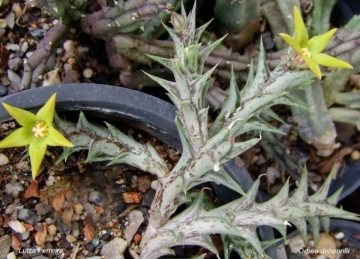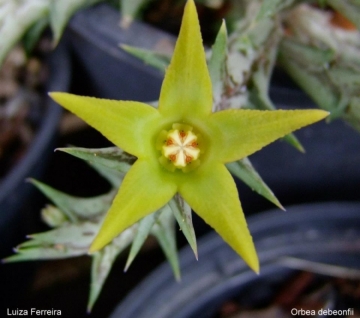Accepted Scientific Name: Orbea denboefii (Lavranos) Bruyns
Aloe 37(4): 74 2000

Angolluma denboefii (Orbea denboefii) Photo by: Luiza Ferreira
Origin and Habitat: Orbea denboefiiSN|30503]]SN|30503]] was found in the Kajiado Distr., near Oloitokitok, Rift Valley in Kenya and it can also be found in neighbouring Tanzania. Type: Kenya. 6-10 km ENE of Oloitokitok, 1350 m
Altitude range: Around 780-1525 metres above sea level.
Synonyms:
Description: Orbea denboefiiSN|30503]]SN|30503]] is a small glabrous, succulent outstanding for its large, mutant golden-yellow flowers developing in gradual succession near the tip of younger stems. The branches are greyish green mottled with brown to purple with prominent conical tubercles, in 4 rows along the stem. Originally described by Lavranos in 1983 as Caralluma denboefiiSN|30505]]SN|30505]], for some years O. denboefii was known under the names Angolluma denboefiiSN|30504]]SN|30504]] or Pachycymbium denboefiiSN|30506]]SN|30506]].
Bibliography: Major references and further lectures
1) John Hunter Thomas “Systematic Botany Monographs” American Society of Plant Taxonomists, 2002
 Angolluma denboefii (Orbea denboefii) Photo by: Luiza Ferreira
Angolluma denboefii (Orbea denboefii) Photo by: Luiza Ferreira Angolluma denboefii (Orbea denboefii) Photo by: Luiza Ferreira
Angolluma denboefii (Orbea denboefii) Photo by: Luiza Ferreira Angolluma denboefii (Orbea denboefii) Photo by: Luiza Ferreira
Angolluma denboefii (Orbea denboefii) Photo by: Luiza FerreiraSend a photo of this plant.The gallery now contains thousands of pictures, however it is possible to do even more. We are, of course, seeking photos of species not yet shown in the gallery but not only that, we are also looking for better pictures than those already present.
Read More... Cultivation and Propagation: Orbea denboefiiSN|30503]]SN|30503]] isn't difficult to grow and flower, but least cold tolerant or more heat demanding than other orbeas, keep dry in winter at a minimum temperature above 10° Celsius.
Spring: When winter ends and they begin to grow again, they will require much water and soaking the pots will no longer put the plants at risk for rot. In the spring they will grow well in partial shade and leaving them out in the rain may provide them with the water they need.
Summer: In the summer months they will tolerate heavy rain, but will be just as happy if the season is dry. It's best to sort out the stems while the plants are resting in the summer before they begin their autumnal growth cycle. They will tolerate very hot weather outdoors as long as they are kept in filtered light and this will encourage them to flower in the Autumn. They also enjoy some fertiliser. Moving the plants as they are developing buds may cause them to spontaneously abort the flowers all together.
Autumn: In the fall keep them outdoors until the night time temperatures drop below the 10°C.
Winter: Winter care presents no problems at 10° C with plenty of light. As soon as they are flowered be sure to take extra precautions to keep them dry, because damp cool conditions when the plants are resting is an invitation to fungal infections, but - according to temperatures –some occasional lit watering may be useful.
Potting medium: Since roots are quite shallow, use a cactus mix or add extra perlite or pumice to regular soil potting soil. A gritty, very free-draining compost is suitable, and clay pots help the plants to dry out between watering. Re-pot every 2 years.
Pest and diseases: Orbeas are generally fairly easy to grow, especially if kept pest-free. They are very susceptible to stem and root mealy bugs, and damage from these may well initiate fungal attack. Any time when there is a dead or dying stem in the pot it is important to remove it immediately and completely before other healthy stems can become ill too, isolate the healthy parts, dry them off, and re-root them in new compost. It should not be exposed to direct sun that make stem turn brown, and stops growth.
Uses: This species is grown as an ornamental in rock gardens and containers.
Propagation: Easiest with stem cuttings. Allow cuttings to dry a day before planting. Stems must be laid (Not buried) on gritty compost and will then root from the underside of the stems. It can also be increased from seeds sowing in spring in moist, sandy peat moss. Barely cover seeds. Seeds germinate quickly.
In any season it's best to lay the stems out for several days before replanting them and then pot them only in dry soil and withhold any water until they begin to shrivel or start growing again.













